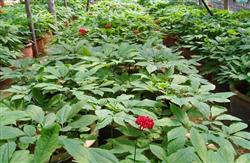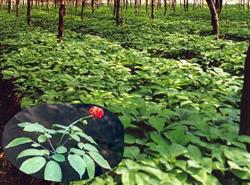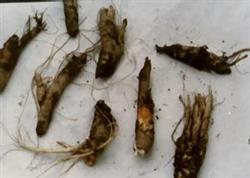How to manage ginseng in autumn, winter and spring?

How to manage ginseng in autumn, winter and spring? Please introduce the method. Autumn, winter and spring are the dormant periods of ginseng overwintering. Field management at this stage is an important production link that can not be ignored. The main task is to prevent cold and preserve soil moisture, the key points of management are: sealing beds in autumn, snow in winter, and digging drainage ditches in spring. The main purpose of sealing the border against cold in autumn is to seal the surface, side and head of the border. This can not only keep the bed soil loose, but also prevent the freezing injury of slow sun. The newly planted ginseng combined with cleaning the drainage ditch, pinch the cleaned ditch soil and work road soil onto the ginseng border and cover it with 15-20cm. It is necessary to paste the border, wrap the border head, clean the field weeds, pour enough water, and disinfect the soil. After disinfecting the soil, evenly cover the leaves, rice straw and corn straw over the bed with 3-5cm, and then seal the overwintering soil with 8-10cm. In this way, it can not only prevent frost and drought, but also prevent rain and snow in autumn, winter and spring from forming slabs on the original ginseng border topsoil, and protect the sunny slopes and windward ginseng from freezing damage. Snow is a treasure to ginseng, but improper use is also harmful. Before freezing in early winter, the snow can not be preserved due to unstable temperature, so it is necessary to prevent snow water from infringing ginseng. Especially in the newly planted and autumn sowing land, the snow on the border should be pushed off in time after snow. After freezing, let it snow naturally, if there is less snow, snow should be put on the border by hand, and the snow around the operation road and the border bed should be pinch to the border surface, so that the snow thickness of the border surface can reach about 15cm, so as to prevent cold and preserve soil moisture. In early spring, the snow begins to melt and often freezes because of unstable temperatures. In order to avoid snow water infringing ginseng, the snow on the border should be pushed down in time. Before and after the Qingming Festival, the drainage ditch should be dug in time to prevent the peach blossom water from washing out the border bed or overflowing the border bed. If ginseng is soaked by peach blossoms, it is easy to rot buds and roots, resulting in serious death of ginseng. After removing the debris from the border and ditch, it is necessary to keep the ginseng ground clean and the water flow smooth, so as to reduce the sclerotia disease of ginseng. Click to get more ginseng planting technology click to get more medicinal material planting technology
- Prev

How to grow ginseng?
How to grow ginseng? Please give us places that introduce the environmental requirements for planting ginseng free of flood, drought, wind and freezing damage. In order to cultivate ginseng in farmland in plain area, it is necessary to choose land with high topography, loose and fertile soil, strong water retention and good drainage. Ginseng likes forest rot zone soil, if the soil organic matter content.
- Next

How to prevent and cure the bacterial soft rot of ginseng?
How to prevent and cure the bacterial soft rot of ginseng? Please introduce the symptoms of bacterial soft rot of ginseng: mainly harmful to the roots. The disease spot is brown soft rot, the edge is clear, round to irregular shape, different size, constant combination, and finally lead to the whole ginseng root soft rot. Squeeze the spot with your hand, there is a white pus overflow, with a thick thorn.
Related
- Fuxing push coffee new agricultural production and marketing class: lack of small-scale processing plants
- Jujube rice field leisure farm deep ploughing Yilan for five years to create a space for organic food and play
- Nongyu Farm-A trial of organic papaya for brave women with advanced technology
- Four points for attention in the prevention and control of diseases and insect pests of edible fungi
- How to add nutrient solution to Edible Fungi
- Is there any good way to control edible fungus mites?
- Open Inoculation Technology of Edible Fungi
- Is there any clever way to use fertilizer for edible fungus in winter?
- What agents are used to kill the pathogens of edible fungi in the mushroom shed?
- Rapid drying of Edible Fungi

